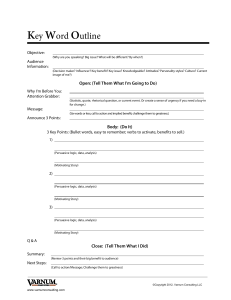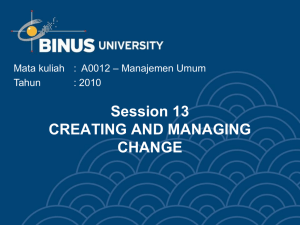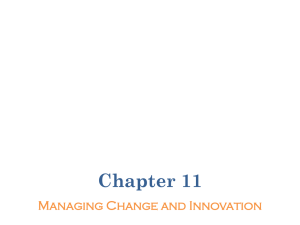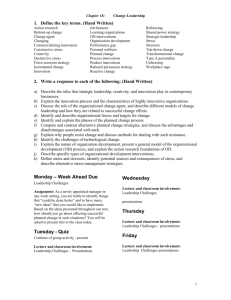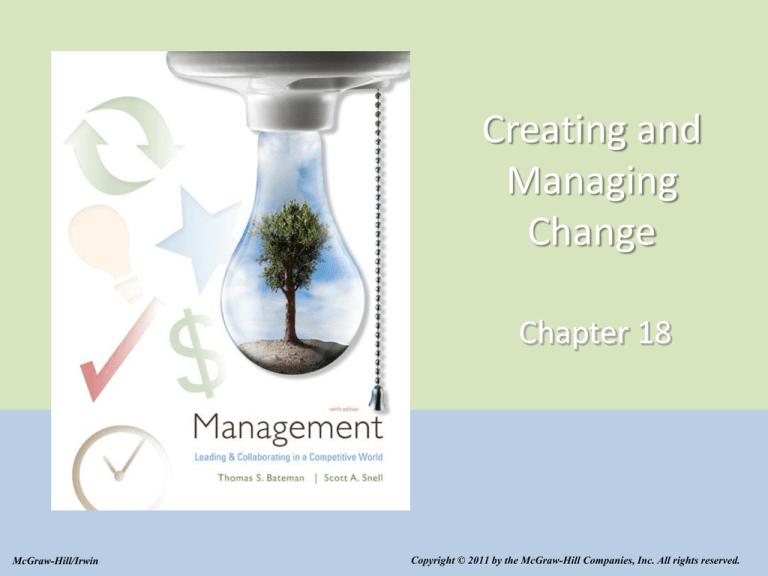
Creating and
Managing
Change
Chapter 18
McGraw-Hill/Irwin
Copyright © 2011 by the McGraw-Hill Companies, Inc. All rights reserved.
Learning Objectives
LO 1 Discuss what it takes to be world class
LO 2 Describe how to manage change
successfully
LO 3 List tactics for creating a successful future
18-2
Becoming World Class
Being world class requires applying the best and
latest knowledge and ideas and having the ability to
operate at the highest standards of any place
anywhere
World-class companies create high-value products
and earn superior profits over the long run
The result is an organization capable of competing
successfully on a global basis
18-3
Sustainable, Great Features
Great companies
Have strong core
values
Are driven by goals
Change continuously
Focus on beating
themselves, not on
beating the
competition
18-4
The Tyranny of the Or
Tyranny of the or
The belief that things must be either A or B and
cannot be both; that only one goal and not
another can be attained
18-5
The Tyranny of the Or
Examples
You must choose either change or stability
Be conservative or bold
Have control and consistency or creative freedom
Do well in the short term or invest for the future
Plan methodically or be opportunistic
Create shareholder wealth or do good for the world
Be pragmatic or idealistic
18-6
The Genius of the And
Genius of the and;
organizational
ambidexterity
Ability to achieve
multiple objectives
simultaneously.
Examples
Purpose beyond profit
and pragmatic pursuit
of profit
Relatively fixed core
values and vigorous
change and movement
Clear vision and
direction and
experimentation
18-7
Core Ideologies in Built-to-Last Companies
Table 18.1
18-8
Organization Development
Organization development (OD)
The system wide application of behavioral science
knowledge to develop, improve, and reinforce the
strategies, structures, and processes that lead to
organizational
effectiveness.
18-9
Organization Development
Strategic
interventions,
helping organizations
conduct mergers and
acquisitions, change
their strategies, and
develop alliances
Technostructural
interventions
relating to
organization structure
and design, employee
involvement, and work
design
18-10
Organization Development
Human resources
management
interventions
Attracting good
people, setting goals,
and appraising and
rewarding
performance
Human process
interventions
Conflict resolution,
team building,
communication, and
leadership.
18-11
Achieving Greatness
Strategy
focused on customers,
continually fine-tuned
based on marketplace
changes, and clearly
communicated to
employees.
Execution
good people, with
decision-making
authority on the front
lines, doing quality
work and cutting costs.
18-12
Achieving Greatness
Culture
one that motivates, empowers people to innovate,
rewards people appropriately, entails strong
values, challenges people, and provides a
satisfying work environment
18-13
Achieving Greatness
Structure
making the organization easy to work in and easy
to work with, characterized by cooperation and
the exchange of information and knowledge
throughout the organization
18-14
Question
A person who creates change is a __________.
A. Changer
B. Change agent
C. Mediator
D. Collaborator
18-15
Managing Change
Shared leadership is crucial to the success of
most change efforts—people must be not just
supporters of change but also implementers
Change agents
People who create change
18-16
Question
One reason for an employee’s resistance to
change is ___________.
A. Inertia
B. Quality
C. Speed
D. Service
18-17
Motivating People to Change
General reasons for
resistance
Inertia
Timing
Surprise
Peer pressure
18-18
Motivating People to Change
Change-specific reasons for resistance
Self-interest
Misunderstanding
Different assessments
Management tactics
18-19
Reasons for Resistance to Change
Figure 18.1
18-20
Motivating People to Change
Figure 18.2
18-21
A General Model for Managing Resistance
Unfreezing
Realizing that current practices are inappropriate
and that new behavior is necessary
Performance gap
The difference between actual performance and
desired performance.
18-22
A General Model for Managing Resistance
Moving
Instituting the change
Refreezing
Strengthening the new behaviors that support the
change
18-23
Force-field Analysis
Force-field analysis
An approach to implementing the unfreezing/
moving/refreezing model by identifying the forces
that prevent people from changing and those that
will drive people toward change
18-24
Specific Approaches to Enlist Cooperation
Education and communication
Participation and involvement
Facilitation and support
Negotiation and rewards
Manipulation and cooptation
Explicit and implicit coercion
18-25
Methods for Managing Resistance to
Change
Table 18.2
18-26
Methods for Managing Resistance to
Change
Table 18.2
18-27
Harmonizing Multiple Changes
Total organization
change
Introducing and
sustaining multiple
policies, practices, and
procedures across
multiple units and
levels.
18-28
Harmonizing Multiple Changes
What is the evidence that the approach really can
produce positive results?
Is the approach relevant to your company’s
strategies and priorities?
Can you assess the costs and potential benefits?
Does it really help people add value through their
work?
Does it help the company focus better on customers
and the things they value?
18-29
Leading Change
Figure 18.3
18-30
Sources of Complacency
Figure 18.4
18-31
Shaping the Future
Reactive change
A response that occurs
under pressure;
problem driven
change.
Proactive change
A response that is
initiated before a
performance gap has
occurred.
18-32
Creating the Future
Adapters
Companies that take
the current industry
structure and its
evolution as givens,
and choose where to
compete
Shapers
Companies that try to
change the structure
of their industries,
creating a future
competitive landscape
of their own design.
18-33
Vast Opportunity
Figure 18.5
18-34
What Should You and Your Firm Do?
Preserve old advantages or create new
advantages?
Lock in old markets or create new markets?
Take the path of greatest familiarity or the path
of greatest opportunity?
Be only a benchmarker or a pathbreaker?
18-35
What Should You and Your Firm Do?
Place priority on short-term financial returns or
on making a real, long-term impact?
Do only what seems doable or what is difficult
and worthwhile?
Change what is or create what isn’t?
Look to the past or live for the future?
18-36
Adding Value, Personally
Table 18.3
18-37
Learning Cycle: Explore, Discover, Act
Figure 18.6
18-38
Level 5 Hierarchy
Figure 18.7
18-39
Destination CEO: Coca Cola Co.
What examples can
Brainstorm some new
you provide of Isdell’s
beverage ideas that
efforts to deliver Coke
Coke might consider
back to the worldfor the future.
class status it had
once enjoyed?
18-40

